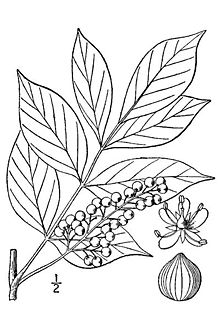Toxicodendron vernix: Difference between revisions
Pinethicket (talk | contribs) Added range map |
No edit summary |
||
| Line 23: | Line 23: | ||
| date =1900 |
| date =1900 |
||
| location =New York |
| location =New York |
||
| pages =94–96 }}</ref> All parts of the plant contain a resin called [[urushiol]] that causes skin and mucous membrane irritation to humans. When burned, inhalation of the smoke may cause the rash to appear on the lining of the lungs, causing extreme pain and possibly fatal respiratory difficulty. |
| pages =94–96 }}</ref> All parts of the plant contain a resin called [[urushiol]] that causes skin and mucous membrane irritation to humans. When burned, inhalation of the smoke may cause the rash to appear on the lining of the lungs, causing extreme pain and possibly fatal respiratory difficulty. Poison Sumac is also the state tree of [[Illinois]]. |
||
==Distribution== |
==Distribution== |
||
Revision as of 04:17, 5 February 2010
| Poison sumac | |
|---|---|

| |
| Poison sumac leaves | |
| Scientific classification | |
| Kingdom: | |
| (unranked): | |
| (unranked): | |
| (unranked): | |
| Order: | |
| Family: | |
| Genus: | |
| Species: | T. vernix
|
| Binomial name | |
| Toxicodendron vernix | |

| |
Poison sumac (Toxicodendron vernix or Rhus vernix) is a woody shrub or small tree growing to 7 m (20 ft) tall.[1] All parts of the plant contain a resin called urushiol that causes skin and mucous membrane irritation to humans. When burned, inhalation of the smoke may cause the rash to appear on the lining of the lungs, causing extreme pain and possibly fatal respiratory difficulty. Poison Sumac is also the state tree of Illinois.
Distribution

Poison sumac grows exclusively in very wet or flooded soils, usually in swamps and peat bogs, in the eastern United States and Canada.[2]
Toxicity
In terms of its potential to cause urushiol-induced contact dermatitis, Poison sumac is far more virulent than its relatives poison ivy and poison oak. According to some botanists, poison sumac is the most toxic plant species in the United States (Frankel, 1991).
The poison shows itself in painful and long continued swellings and eruptions.[1] Specific information on prevention and treatment of Toxicodendron rashes is provided in Urushiol-induced contact dermatitis.
Notes
- ^ a b Keeler, Harriet L. (1900). Our Native Trees and How to Identify Them. New York: Charles Scriber's Sons. pp. 94–96.
- ^ USDA Natural Resources Conservation Service: Toxicodendron vernix
References
- Frankel, Edward, Ph.D. 1991. Poison Ivy, Poison Oak, Poison Sumac and Their Relatives; Pistachios, Mangoes and Cashews. The Boxwood Press. Pacific Grove, Calif. ISBN 0940168189.
External links
- Wisconsin page for poison sumac.
- Poison ivy / oak / sumac in "The Medicinal Herb FAQ".
- The Poison Sumac Page—Photos and facts about poison sumac.
- Poison Oak at Wayne's Word.
